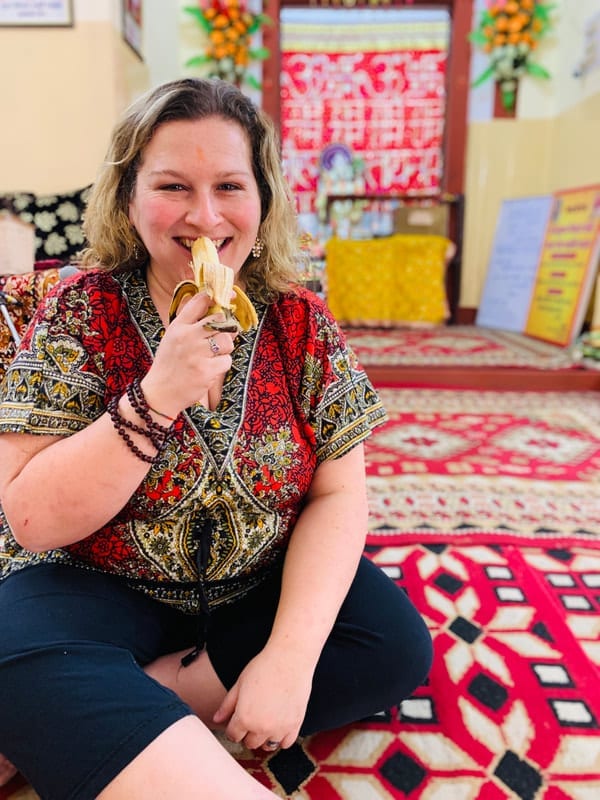If you grew up in an Abrahamic, Western context, chances are that you answered “True.” I was certainly taught that Hinduism is a polytheistic religion all the way through grade school and high school. Let’s set aside the word “religion” for the purposes of this piece because many would argue that Hinduism is not a religion at all, and the word itself is a rather new invention influenced by British colonial rule. Hinduism is a spiritual path best described by the teaching of sanatan dharma: truth is universal, timeless, and unchanging. A Hindu saint who influences me, Neem Karoli Baba (Maharaj-ji) taught Sub Ek, or “all one.” The precepts that all major religions have in common is the essence of this truth, and followers of this teaching do not hold their path in supremacy above others. The rest is really just details, for we know that truth expresses itself in myriad ways. And in the tradition that we generally refer to as Hinduism, there is only one supreme God—the various “gods” like Krishna, Shiva, Sita, Ram, Ganesh, Kali, and Hanuman are simply manifestations of God; different threads through which Divinity is expressed. As scholar Eknath Easwaran explains in his commentary on The Bhagavad Gita, “From the earliest times, Hinduism has proclaimed one God while accommodating worship of him (or her, for to millions God is the Divine Mother) in many different names” (p. 22).
I adore this teaching, as a humanitarian whose heart breaks to see the devastation caused throughout history in the name of religion and fundamentalism. I also adore it as a person with a dissociative mind who sees the world through multiple lenses and angles. In this piece I hope to demonstrate how getting familiar with the Hindu gods can offer a beautiful systemic metaphor for people to explore their internal world. Yes, there is one God—in the Hindu tradition, God shows up in roughly 330 million ways (the approximate number of major and minor gods). Raised primarily as a Roman Catholic, it always seemed plausible to me that the Almighty could choose to manifest in human form, born of a woman, in the person of Jesus. And I do love Jesus the social rebel and adore that many people find God’s love through Jesus. I could just never get behind the teaching, at least with my whole heart, that Jesus died for my sins and that professing belief in him is the only way to salvation. So it’s safe to say that even as a child, sanatan dharma was alive within me.
I still hang out in Catholic circles, even though I dislike mainstream Catholic social teaching. I draw strength from many aspects of Catholicism and similar Christian paths, and I have a particular fondness for the saints. I adore the saints for a similar reason to why I love the Hindu gods; the saints represent the different ways that God shows up in the world. There are many saints whose lives and teachings have spoken to me, saints like Therese of Lisieux, Teresa of Avila, Hildegard of Bingen, Benedict, Anthony, Jude, Augustine, Ignatius, Maria Goretti, and St. John of the Cross. Not to mention those who are not officially “saints” according to the Vatican yet whose lives and writings inspire me, specifically Fr. Henri Nouwen and Fr. Thomas (Louis) Merton. I love them for their humanity and for the overcoming of struggle, owing all glory to the Divine.
You may be familiar with the concept of patron saints. For example, St. Anthony is the patron saint of lost objects, St. Jude is the patron saint of lost causes, and while she’s not been officially labeled this, for me St. Hildegard of Bingen is a patroness of the holistic and expressive arts. Catholics pray to saints who they feel most connected to or who most get their struggle, asking them to intervene before God. For me, the Hindu gods hold similar appeal; the major difference is that they are not intermediaries, they are actually parts or aspects of the One Divine presence. Ganesh, the mighty elephant, is known as the remover of obstacles. Sonu, one of my drivers on my pilgrimage to India shared with me, “Pray to Ganesh first; he removes the blocks that keep you from getting to everything else.” Like many people keep a rosary or medal hanging from their car mirror, he keeps a little Ganesh on his dashboard. Ganesh is an expression of the God, the Divine remover of obstacles.
In Hinduism, gods are often paired by their masculine and feminine qualities to represent the union of consciousness (masculine) and energy (feminine). For instance, you often see Krishna and Radha together, Shiva and Parvati, and my favorite holy couple, Sita and Ram. One of the most meaningful stories in the Hindu tradition is that of Sita (energy), Ram (consciousness), and Hanuman (the monkey god representing breath and the ability to shape shift. Once, the demon Ravana (who represents the ego mind) lured and captured Sita (energy) to exploit her for his own benefit. Ram called upon his devoted servant, the beloved Hanuman. Hanuman mustered the forces of his entire monkey army and they found Sita at the southern tip of India (symbolic because in our lower chakras is where we expel all of our life energy that we waste through worry and fear). They rescued her so she could be reunited with her beloved. Hanuman’s role in this story represents the power of the breath to reunite energy and consciousness. In this powerful fusion of energy and consciousness made possible by the breath, order is restored and we are deeply healed. It is amazing to me how Hanuman took on a large, angry form to destroy Ravana and the city of Lanka by fire; and yet he was able to assume a small, gentle form when he came to rescue mother Sita so she would not be afraid.
If you’ve read my work before on this blog, you know that I have a thing for Hanuman. To use Catholic language, I have a great devotion to him. Yes, his qualities displayed in the Sita-Ram story are a big part of why I love him. I am also drawn to the teaching of Hanuman as a bridge—because he is a monkey, he is the bridge between the human world and the animal world. And in my work I aspire to be a bridge. As a woman living with and healing from a dissociative disorder, all work on myself requires that I bridge the aspects of myself to live in wholeness. As a trauma survivor I draw great strength from Hanuman. As a miracle baby and incarnation of Shiva, born through the intervention of the wind God, others were threatened by Hanuman as his powers began to manifest in the form of a rather naughty toddler. The monkey king, Bali, threatened by Hanuman, devised a poisonous concoction of five metals to kill Hanuman. When Hanuman ingested the potion it only made him more brilliant, graceful, and powerful. A better metaphor for post-traumatic growth I have never heard. Jai Hanuman! Victory to Hanuman and victory to the Hanuman spirit within me.
Just like there are many parts of me, there are many gods that speak to my various parts. In addition to Hanuman I have great devotions to Saraswati, the goddess of music, art, and knowledge. Indeed her quality of knowledge, or Pragya, is the origin of the spiritual name I was given. I cannot think of a better goddess for an expressive artist to serve! Many other feminine expressions like Kali, Sita, Durga, and Lakshmi also give me strength. Just like Christianity uses the term trinity, Hinduism also makes use of a similar concept with the holy trinity of Brahma (the creator), Vishnu (the preserver) and Shiva (the destroyer) governing the necessary functions of life. On the feminine side, Parvati (fertility, love, beauty), Saraswati, and Lakshmi (wealth, fortune, and prosperity) compose a Tridev, or trinity. Whether you embrace these stories and qualities as spiritual teaching or as myth, there are numerous opportunities to notice where you experience resonance. Whether you are doing parts work for your own healing or with clients, the Hindu gods offer rich opportunities for helping one describe their own internal system with these metaphors and allegories. The stories are numerous and if you can step outside of your spiritual comfort zone and explore some of them, you may discover that they lead you closer to the oneness that is God because they can meet you as you are right now.
And isn’t one of the goals of parts work in healing trauma to honor and recognize the parts yet let them lead us to a sense of wholeness or integration? If the word integration is a sticking point for you—don’t use it. Indeed, many of us who’ve struggled with dissociative issues over the years can equate integration with a therapist’s desire to smash out or ignore what the parts have to say. So while the word integration may work for you, consider replacing it with wholeness or totality. This idea works similar to how the Hindu gods operate—many awesomely beautiful parts that compose one, unified whole. Even from this place of wholeness, the parts can be called upon when they are needed. And like in my internal system, one god/part (like Hanuman for me) may be the key to establishing balance and peace in the system.
There is one final aspect of Hindu teaching I wish to discuss here that you may also find useful in your own path of healing as it relates to parts. In the Hindu system the gods are constantly interconnecting and incarnating as other gods (e.g., Hanuman is an incarnation of Shiva, Ram is an incarnation of Vishnu, etc.) and this vibrancy serves the whole. A demon, like Ravana in the Hanuman story, is a part that thinks it is the whole – a part that tries to override the system for its own desires or survival. So the next time you talk about your demons, remember that you are not your demons. Like Ravana the ego mind, they are just an aspect of your experience that’s trying to overtake your entire system. Instead, consider learning to call upon other warriors to help you understand sanatan dharma–that truth is one. That we are not separate. And the largest most healing truth I’ve learned from studying Hinduism is that I am not my demons. I am not even my singular parts. Rather, learning about, connecting with, and healing my parts has allowed me to uncover the truth of who I really am, never separated from Divine presence. Even if working in the Hindu system like this doesn’t do it for you, I hope that you find something in your own faith tradition or in other areas of life (e.g., mythology, pop culture) that helps you to explore your internal world. May we all ultimately live in wholeness, honoring how every part is connected.
To read more:
Achuthananda, Swami (2013). Many many many gods of Hinduism: Culture, concepts, and controversies. Reliant.
Johari, H. (2016). Spiritual traditions of India coloring book. Destiny Books.
Markus, P. (2015). Love everyone: The transcendent wisdom of Neem Karoli Baba told through the stories of westerners whose lives he transformed. New York: HarperCollins Publishers.
Reference:
Easwaran, E. (2007). The Bhagavad Gita—Translation and commentary by Eknath Easwaran (2nd ed). Tomales, CA: Blue Mountain Center for Meditation.















2 Responses
Thank you so much for this gift! Jai bajrangi baba Hanuman
There are so many metaphors in this piece. I particularly like the discussion of a part that thinks it’s a whole. I can so identify with this. The concept of wholeness is a beautiful idea. I think I mostly appreciate the fact that what I perceived as a negative image is not really negative. So just maybe the parts of me that I perceived as negative are in fact not.
One thing that does strike me is that much damage was done by well intentioned people in the recovery world. When I was out there using it was obvious that I engaged in behavior that was pretty destructive. When I got sober, the treatment community helped me identify parts of me that were “sick” and needed to be eliminated. No wonder I didn’t know who I really was.